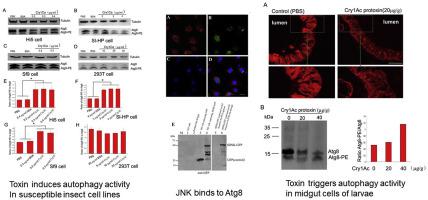当前位置:
X-MOL 学术
›
Pestic. Biochem. Phys.
›
论文详情
Our official English website, www.x-mol.net, welcomes your
feedback! (Note: you will need to create a separate account there.)
Bacillus thuringiensis cry toxin triggers autophagy activity that may enhance cell death
Pesticide Biochemistry and Physiology ( IF 4.2 ) Pub Date : 2021-01-01 , DOI: 10.1016/j.pestbp.2020.104728 Yongbo Yang , Xiaoying Huang , Wanli Yuan , Yang Xiang , Xueqin Guo , Wei Wei , Mario Soberón , Alejandra Bravo , Kaiyu Liu
Pesticide Biochemistry and Physiology ( IF 4.2 ) Pub Date : 2021-01-01 , DOI: 10.1016/j.pestbp.2020.104728 Yongbo Yang , Xiaoying Huang , Wanli Yuan , Yang Xiang , Xueqin Guo , Wei Wei , Mario Soberón , Alejandra Bravo , Kaiyu Liu

|
Although it is well known that Bacillus thuringiensis Cry toxins kill insect pest by disrupting midgut cells of susceptible larvae through their pore formation activity, it is not clear what intracellular events are triggered after pore formation on the cell membrane of the target cells. Here we analyzed the role of Cry toxins on autophagy activation using several cell lines as models as well as in Helicoverpa armigera larvae. The selected insect cell lines (Hi5, Sl-HP and Sf9) were susceptible to activated Cry1Ca toxin, but only Sl-HP cells were also susceptible to activated Cry1Ac toxin. In contrast, the mammalian cell line 293 T was not susceptible to Cry1Ac or to Cry1Ca. Results show that Cry toxins induced autophagy only in the susceptible cell lines as shown by the analysis of the changes in the ratio of Atg8-PE to Atg8 and by formation of autophagosome dots containing Atg8-PE. The Cry1Ac enhanced autophagy in the midgut tissue of H. armigera larvae. Silencing expression of specific genes by RNAi assays confirmed that the autophagy induced by activated Cry toxins was dependent on AMPK and JNK pathways. Finally, inhibition of autophagy in the cell lines by specific inhibitors or RNAi assays resulted in delayed cell death triggered by Cry toxins, suggesting that the increased autophagy activity observed after toxin intoxication may contribute to cell death.
中文翻译:

苏云金芽孢杆菌cry 毒素触发自噬活动,可能会增强细胞死亡
虽然众所周知,苏云金芽孢杆菌 Cry 毒素通过其成孔活动破坏易感幼虫的中肠细胞来杀死害虫,但尚不清楚靶细胞的细胞膜上形成孔后会触发什么细胞内事件。在这里,我们使用几种细胞系作为模型以及棉铃虫幼虫分析了 Cry 毒素对自噬激活的作用。选定的昆虫细胞系(Hi5、Sl-HP 和 Sf9)对活化的 Cry1Ca 毒素敏感,但只有 Sl-HP 细胞也对活化的 Cry1Ac 毒素敏感。相比之下,哺乳动物细胞系 293 T 对 Cry1Ac 或 Cry1Ca 不敏感。结果表明,Cry 毒素仅在易感细胞系中诱导自噬,如对 Atg8-PE 与 Atg8 比率变化的分析以及包含 Atg8-PE 的自噬体点的形成所示。Cry1Ac 增强了棉铃虫幼虫中肠组织的自噬。通过 RNAi 测定沉默特定基因的表达证实了激活的 Cry 毒素诱导的自噬依赖于 AMPK 和 JNK 途径。最后,通过特定抑制剂或 RNAi 测定抑制细胞系中的自噬导致由 Cry 毒素触发的细胞死亡延迟,这表明在毒素中毒后观察到的自噬活性增加可能导致细胞死亡。通过 RNAi 测定沉默特定基因的表达证实了激活的 Cry 毒素诱导的自噬依赖于 AMPK 和 JNK 途径。最后,通过特定抑制剂或 RNAi 测定抑制细胞系中的自噬导致由 Cry 毒素触发的细胞死亡延迟,这表明在毒素中毒后观察到的自噬活性增加可能导致细胞死亡。通过 RNAi 测定沉默特定基因的表达证实了激活的 Cry 毒素诱导的自噬依赖于 AMPK 和 JNK 途径。最后,通过特定抑制剂或 RNAi 测定抑制细胞系中的自噬导致由 Cry 毒素触发的细胞死亡延迟,这表明在毒素中毒后观察到的自噬活性增加可能导致细胞死亡。
更新日期:2021-01-01
中文翻译:

苏云金芽孢杆菌cry 毒素触发自噬活动,可能会增强细胞死亡
虽然众所周知,苏云金芽孢杆菌 Cry 毒素通过其成孔活动破坏易感幼虫的中肠细胞来杀死害虫,但尚不清楚靶细胞的细胞膜上形成孔后会触发什么细胞内事件。在这里,我们使用几种细胞系作为模型以及棉铃虫幼虫分析了 Cry 毒素对自噬激活的作用。选定的昆虫细胞系(Hi5、Sl-HP 和 Sf9)对活化的 Cry1Ca 毒素敏感,但只有 Sl-HP 细胞也对活化的 Cry1Ac 毒素敏感。相比之下,哺乳动物细胞系 293 T 对 Cry1Ac 或 Cry1Ca 不敏感。结果表明,Cry 毒素仅在易感细胞系中诱导自噬,如对 Atg8-PE 与 Atg8 比率变化的分析以及包含 Atg8-PE 的自噬体点的形成所示。Cry1Ac 增强了棉铃虫幼虫中肠组织的自噬。通过 RNAi 测定沉默特定基因的表达证实了激活的 Cry 毒素诱导的自噬依赖于 AMPK 和 JNK 途径。最后,通过特定抑制剂或 RNAi 测定抑制细胞系中的自噬导致由 Cry 毒素触发的细胞死亡延迟,这表明在毒素中毒后观察到的自噬活性增加可能导致细胞死亡。通过 RNAi 测定沉默特定基因的表达证实了激活的 Cry 毒素诱导的自噬依赖于 AMPK 和 JNK 途径。最后,通过特定抑制剂或 RNAi 测定抑制细胞系中的自噬导致由 Cry 毒素触发的细胞死亡延迟,这表明在毒素中毒后观察到的自噬活性增加可能导致细胞死亡。通过 RNAi 测定沉默特定基因的表达证实了激活的 Cry 毒素诱导的自噬依赖于 AMPK 和 JNK 途径。最后,通过特定抑制剂或 RNAi 测定抑制细胞系中的自噬导致由 Cry 毒素触发的细胞死亡延迟,这表明在毒素中毒后观察到的自噬活性增加可能导致细胞死亡。











































 京公网安备 11010802027423号
京公网安备 11010802027423号